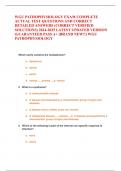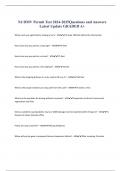-
1. Exam (elaborations) - 2024 nu 518 exam 2 complete practice exam with 100 actual questions and correct det...
-
2. Exam (elaborations) - Actual ati pn comprehensive online practice 2023 a and b (a new updaed version 2024...
-
3. Exam (elaborations) - Adult medical surgical proctored 2023 actual exam real questions and correct detail...
-
4. Exam (elaborations) - Ati pn comprehensive exit exam complete actual exam 2024 real questions and correct...
-
5. Exam (elaborations) - Ati pn fundamentals online practice 2024 a actual exam real questions and correct d...
-
6. Exam (elaborations) - Ati rn adult medical surgical nursing exam test bank complete test bank with actual ...
-
7. Exam (elaborations) - Cop4600 final exam study guide 2024 (a new updated version) latest complete actual ...
-
8. Exam (elaborations) - Fnp 590 midterm and fiinal exam complete actual exam real questions and correct det...
-
9. Exam (elaborations) - Hondros bio 117 exam 1 latest actual exam real questions with well elaborated answe...
-
10. Exam (elaborations) - Latest cisec exam complete actual exam real questions and correct detailed answers ...
-
11. Exam (elaborations) - Roadcraft actual questions 2024-2025(a new updated version) latest real questions a...
-
12. Exam (elaborations) - Tceq class d water license exam latest actual exam real questions and correct detai...
-
13. Exam (elaborations) - Wgu d426 exam latest complete real exam actual questions and well elaborated answer...
-
14. Exam (elaborations) - Wgu it foundations –d393 :2024 comptia a+ core 1 exam prep latest updated version ...
-
15. Exam (elaborations) - Actual fac- c certification exam newest complete actual exam real questions and corre...
-
16. Exam (elaborations) - Ancc fnp exam and practice exam newest actual exam complete 350 questions and correct...
-
17. Exam (elaborations) - Ancc med surg certification exam complete actual exam questions and correct verified ...
-
18. Exam (elaborations) - Ardms obstetrics /ardms ob/gyn actual exam and practice exam newest 2024 complete que...
-
19. Exam (elaborations) - Ati capstone fundamentals proctored exam actual exam complete exam questions with det...
-
20. Exam (elaborations) - Ati fundamentals proctored exam test bank latest complete real questions and correct ...
-
21. Exam (elaborations) - Bio 152 final exam actual exam 2 versions complete 400 questions with detailed verifi...
-
22. Exam (elaborations) - California notary exam 2024 newest exam and practice exam questions newest actual exa...
-
23. Exam (elaborations) - Capstone ati comprehensive predictor 2020 form a and b each form with 180 questions
-
24. Exam (elaborations) - Ccds exam 2024 actual exam complete 400 questions with detailed verified answers (100...
-
25. Exam (elaborations) - Chamberlain exit exam latest actual exam 2024 questions and 100% correct answers
-
26. Exam (elaborations) - Colibri real estate exam actual exam 2 versions (version a and b) complete 300 questi...
-
27. Exam (elaborations) - Comp 283 galen latest 2025 studyguide questions and 100% correct answers | a+ grade
-
28. Exam (elaborations) - Earthwork exam and practice exam newest actual exam complete 200 questions and correc...
-
29. Exam (elaborations) - Hazmat awareness final exam latest actual exam questions and detailed correct answers...
-
30. Exam (elaborations) - Him final exam newest actual exam real questions and correct detailed answers (correc...
-
31. Exam (elaborations) - Indiana cosmetology state board exam 2025 questions and detailed correct answers | a+...
-
32. Exam (elaborations) - Med aide state exam 2024 actual exam and practice exam questions complete accurate ex...
-
33. Exam (elaborations) - Nj health and accident insurance exam 2024 actual exam complete accurate exam questio...
-
34. Exam (elaborations) - Ods final exam 2024 newest actual exam versions complete accurate exam questions with...
-
35. Exam (elaborations) - Ods moodle final exam actual exam 2024- 2025 complete accurate exam questions with de...
-
36. Exam (elaborations) - Pnr 309 midterm exam 2024 actual exam complete accurate exam questions with detailed ...
-
37. Exam (elaborations) - Texas lpc jurisprudence actual exam 2024 newest 2 versions complete 130 questions wit...
-
38. Exam (elaborations) - Washington real estate fundamentals exam 2024 actual exam complete 400 questions with...
-
39. Exam (elaborations) - Wgu d096 fundamentals of diverse learning actual exam real questions and correct deta...
-
40. Exam (elaborations) - 2024 psychiatry eor exam testbank (a new updated version) 2024-2025 actual exam wit...
-
41. Exam (elaborations) - 2025 amca practice test 1,2 and 3 each test contains complete actual questions and...
-
42. Exam (elaborations) - Aanp board exam complete actual exam real questions and correct detailed answers 20...
-
43. Exam (elaborations) - Aanp board exam complete actual exam real questions and correct detailed answers 20...
-
44. Exam (elaborations) - Ati critical care dosage calculations latest complete real exam questions and corre...
-
45. Exam (elaborations) - Ati mental health proctored exam complete actual exam questions and correct verifie...
-
46. Exam (elaborations) - Ati pn fundamentals proctored 2025 testbank complete actual exam with real questions...
-
47. Exam (elaborations) - Cpa ethics exam questions newest complete test questions and correct detailed answer...
-
48. Exam (elaborations) - Davis advantagepatho test 1 newest actual test with complete real questions and cor...
-
49. Exam (elaborations) - Dynatrace pro certification actual exam complete real questions and correct verified...
-
50. Exam (elaborations) - Hesi fundamentals exam 2 newest complete actual questions and correct verified answ...
-
51. Exam (elaborations) - Hesi pharmacology practice exam testbank with nclex pn style study questions latest...
-
52. Exam (elaborations) - Newest hesi mental health exam actual exam complete 140 real questions and correct ...
-
53. Exam (elaborations) - Nz nursing state exam complete actual exam 2024 with real questions and correct ver...
-
54. Exam (elaborations) - Otfit certification exam actual exam with complete real questions and correct detail...
-
55. Exam (elaborations) - Pathophysiology exam testbank latest with complete actual test questions and correc...
-
56. Exam (elaborations) - Pathophysiology final exam complete actual exam questions and correct detailed answ...
-
57. Exam (elaborations) - Real estate u final exam actual exam complete real questions and correct detailed a...
-
58. Exam (elaborations) - Rn ati fundamentals online practice 2024 a complete actual exam with approved questi...
-
59. Exam (elaborations) - Rn hesi exit exam testbank complete exam with 160+ actual questions and well elabor...
-
60. Exam (elaborations) - Utah health and life insurance exam testbank complete actual exam 150 real question...
-
61. Exam (elaborations) - Washington state property and casuality insurance exam complete actual exam real qu...
-
62. Exam (elaborations) - Washingtone life and health (disability) 2025 complete actual exam real questions an...
-
63. Exam (elaborations) - Wgu pathophysiology exam complete actual test questions and correct detailed answer...
-
64. Exam (elaborations) - Ati proctored pharmacology exam/ questions format 2024 actual exam complete 500 ques...
-
65. Exam (elaborations) - Course 1 - foundations of digital marketing & e�commerce test questions and answers l...
-
66. Exam (elaborations) - Digital marketing foundations test questions and answers latest (verified answers) 2...
-
67. Exam (elaborations) - Final exam questions property and casualty - nj state exam with study guide exam 202...
-
68. Exam (elaborations) - Fire instructor 1 final exam newest, 2024/ 2025, actual exam questions and correct ...
-
69. Exam (elaborations) - Hesi pharmacology v1 exam newest, 2024/ 2025, actual exam questions and correct det...
-
70. Exam (elaborations) - Icc california ust service technician exam newest 2024 actual exam 400 questions an...
-
71. Exam (elaborations) - Mkt421t wk 5 - apply course post assessment test questions and answers latest (verif...
-
72. Exam (elaborations) - My california icc service tech exam newest, 2024/ 2025, actual exam questions and co...
-
73. Exam (elaborations) - Nightingale pathophysiology midterm exam newest, 2024/ 2025, actual exam questions a...
-
74. Exam (elaborations) - Nj casualty test exam newest, 2024/ 2025, actual exam questions and correct detailed...
-
75. Exam (elaborations) - Nj property producer exam exam newest, 2024/ 2025, actual exam 250 questions and cor...
-
76. Exam (elaborations) - Nj property, casualty, and auto licensing exam exam newest, 2024/ 2025, actual exam ...
-
77. Exam (elaborations) - Nj psi property and casualty exam exam newest, 2024/ 2025, actual exam questions and...
-
78. Exam (elaborations) - Pharmacology evolve hesi exam newest, 2024/ 2025, actual exam questions and correct ...
-
79. Exam (elaborations) - Practice questions cph exam newest, 2024/ 2025, actual exam questions and correct d...
-
80. Exam (elaborations) - Proctor ob ati exam newest, 2024/ 2025, actual exam questions and correct detailed ...
-
81. Exam (elaborations) - Property and casualty insurance exam questions and answers 2024-2025
-
82. Exam (elaborations) - Psi exam property and casualty exam newest, 2024/ 2025, actual exam questions and co...
-
83. Exam (elaborations) - Psi nj real estate exam, psi practice test exam newest, 2024/ 2025, actual exam ques...
-
84. Exam (elaborations) - Psi practice exam nj exam newest, 2024/ 2025, actual exam questions and correct deta...
-
85. Exam (elaborations) - Psych 1106 questions and answers latest (verified answers 2025
-
86. Exam (elaborations) - Real hesi pharmacology exam newest, 2024/ 2025, actual exam questions and correct d...
-
87. Exam (elaborations) - Student study guide for aphy 101 midterm question and answers
-
88. Exam (elaborations) - Utah notary exam, practice exam and study guide newest 2024 actual exam questions a...
-
89. Exam (elaborations) - Virtual ati maternal newborn assessment exam newest, 2024/ 2025, actual exam questi...
-
Show more





